The Checker Maven
The World's Most Widely Read Checkers and Draughts Publication
Bob Newell, Editor-in-Chief
Published every Saturday morning in Honolulu, Hawai`i
Noticing missing images? An explanation is here.
Demolition

As we delve further into Willie Ryan's famed Tricks Traps & Shots of the Checkerboard, we come across still more interesting and useful positions. This month we look into A Scotsman's Scoop and Denvir's Demolition. Listen up as Willie himself explains.
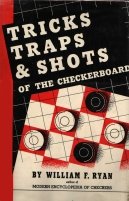
A Scotsman's Scoop
I am unable to find the appended trim snare recorded by any previous connoisseur of the stroke art. It was shown to me by Paul R. Semple, of Martins Ferry, Ohio, who reports he got it from an old Scotsman. Old or new, it's a practical example and belongs in every checker enthusiast's notebook. Move:
11-15 23-18 9-14 18-11 8-15 22-17 4-8 26-23 7-11 23-19 5-9 30-26 9-13---A. See the diagram.
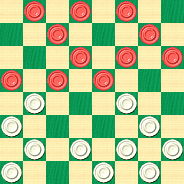
WHITE
White to Play and Win
W:W17,19,21,24,25,26,27,28,29,31,32:B1,2,3,6,8,10,11,12,13,14,15.
A---This is where black bites the dust. The following moves will bring about a draw: 15-18, 19-15, 10-19, 17-10, 6-15, 27-23, 18-27, 32-7, 3-10, 26-23, 8-11, 25-22, 9-14, 29-25, 2-6, 22-17, 15-18, 24-19, 18-27, 31-24, 11-15, 24-20, 15-24, 28-19, 14-18, 17-14, etc. Wm. F. Ryan.
Denvir's Demolition
9-14 22-18 5-9 25-22 11-16 24-19 8-11 27-24---A 16-20 31-27 11-16 29-25 4-8 19-15 10-19 24-15 7-11 22-17
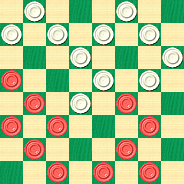
BLACK
Black to Play and Win
B:W32,30,28,27,26,25,23,21,18,17,15:B20,16,14,12,11,9,8,6,3,2,1.
The stage is all set for a startling stroke, leaving white hopelessly beaten. This clever whirligig is generally credited to the late John T. Denvir of Chicago, but it was probably known and shown by other champions before he was born.
A---A losing move often made by beginners, after which there is no scientific salvation. Either 22-17, 30-25, or 28-24 will draw.
After trying the problems, you don't need to be a Scotsman to demolish all difficulties by clicking on Read More for the solutions.![]()
Bowen and Lyman's Double Play
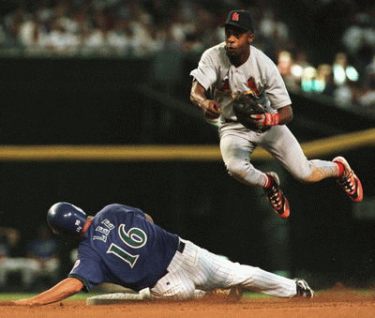
We hope you managed to turn last month's Triple Play but if not, here's a chance to make a double play instead, as our lessons in Checker School continue with a pair of related positions.
In the first problem, White is a man up but Black is going to quickly even the count. How is White to pull off a win?
In the second problem, forces are even, but the White king is pursuing the lonely-looking Black men. Can you show how Black can save the draw?
BLACK
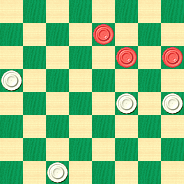
WHITE
White to Play and Win
W:W13,19,20,30:B7,11,12.
WHITE

BLACK
Black to Play and Draw
B:W30,20,K7:B19,18,10.
Whether it's short to second to first or some other way, turn the double play before clicking on Read More to see if your solution is "safe."![]()
White to Move and Draw, Again

Last time we presented a less usual "move and draw" stroke problem, and we liked the concept so much, we're presenting yet another of the same ilk. At least subjectively, though, we think this one is a bit easier, but you'll have to draw your own conclusion.
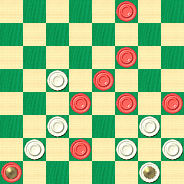
WHITE
White to Move and Draw
W:W14,22,24,25,27,28,K32:B3,11,15,18,19,20,26,K29.
Sketch your solution, and don't erase it until you've clicked on Read More to see if everything is in line.![]()
Fourth Of July Race

Fourth of July, coming up in a few days from the date of publication of this article, is of course the Independence Day holiday here in the US. It's invariably celebrated with fireworks, picnics, and games.... including many a Fourth of July race.
Can you win the race against our relentless clock and solve our July speed problem? Click below to show the problem and start the clock. Our problem is a bit on the easier side, so that you'll have more time to spend at the picnic.
July Speed Problem (easy)
When you have your solution, don't lose time; click on Read More to check your answer.![]()
The Wild Bear Is Still On The Loose!

Brian Hinkle's ferocious bear remains on the loose (click on the link to see the problem again) with the large reward as yet unclaimed. And so, Brian is increasing the bounty one last time, to a whopping $100, to which The Checker Maven will add a free copy of the WCC Platinum computer programs, delivered to your door on 13 CDs (a $25 value).
This is your final opportunity to trap the bear and win the reward! If you have the solution, send it to Brian at once. By the first weekend of September, if there is no winner, the reward will go unclaimed. Don't let that happen! Solve the problem and trap the bear right away!![]()
The prize will be awarded at the sole judgment and discretion of Brian Hinkle, whose decision will be final and not subject to appeal. The Checker Maven does not offer or guarantee the cash portion of this prize. Offer void where prohibited, taxed, or restricted by law. Staff and relatives of staff of any of the Mr. Fred Investments group of companies are not eligible to participate.
Trouble In The Old Fourteenth

From time to time, we like to recall a classic position, one that in a way is like excellent brandy. If you've experienced it before, you will anticipate the fine flavor and be glad to enjoy it again; and if you haven't previously had the pleasure, you're in for a sophisticated and memorable treat.
Today, we're bringing back a trap in the popular go-as-you-please Old Fourteenth opening, said opening so-named simply because it was the fourteenth item in early editions in the ancient and venerable checker books of Payne and Sturges. Here's a run-up to the position of interest:
11-15 23-19 8-11 22-17 4-8 17-13 15-18 24-20 11-15 28-24 8-11 26-23---A 9-14---B 31-26 18-22?
A---25-22 might be considered the main line but this move is perfectly sound.
B---3-8 also draws.
The situation now looks this way:
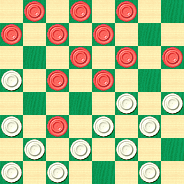
WHITE
White to Play and Win
B:W20,14,13,12,10,9,8,7,6,4,3,1:B32,31,30,28,27,26,23,22,21,19,18,11.
Over the board, and without your computer or your opening books, can you find the line of play that wins for White? Can you correct Black's losing move? We're guessing that the more experienced readers will find their way here, but for the rest of us, it could be a bit of a challenge.
No matter where you stand, you can uncap the solution and drink deeply of traditional checker knowledge by clicking on Read More.![]()
Hefter's Triple Play

This month's lesson in Checker School is due to Mr. Charles Hefter, famed analyst, problemist, and player, who held forth in the last part of the 19th century. We present three positions, closely related but with slight changes from one to the next. Yet, as we well know, subtle differences matter a great deal in our game. These studies were originally published decades ago in Ben Boland's Famous Positions in the Game of Checkers, but remain fresh and interesting today.
BLACK
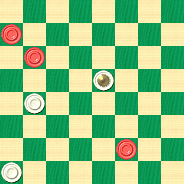
WHITE
White to Play and Win
W:WK15,17,29:B5,9,27.
BLACK
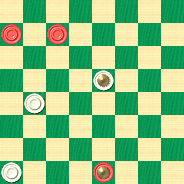
WHITE
White to Play and Win
W:WK15,17,29:B5,6,K31.
WHITE

BLACK
Black to Play and Draw
B:W21,K18,17:BK27,9,5.
Try out these problems and see if you can retire the opposition by turning a triple play. Then, clicking on Read More will bring you Ben Boland's complete analysis, notes, play, and variations, all without missing a single pitch.![]()
A New Book And A Great Quote

It's no secret that here at The Checker Maven we invest in as many checker books as our funding allows. This week, we received a new book by Dr. Harold Schneider, with the unusual title Board Game Tournaments for the Fun, Profit, and Professionalism of the Public. (The associated web site was here but has since gone dark.) It's a book that is every bit as unusual as the title, covering a wide variety of game-related subjects, but concentrating, of course, on checkers.
We'll publish a full review on our Book Review page in due course (though with our current large backlog, it may be some little while). But we can't resist transcribing a line from the back cover of the book, wherein Dr. Schneider gives us what is very likely the most quotable quip in the entire history of our game:
Excluding the game of romance between men and women, it is the number one fun game in the world.
Just try to top that one! We think, in fact, that Dr. Schneider is right on the money with his assessment.![]()

Bumped Off

It's time for another installment from Willie Ryan's classic Tricks Traps & Shots of the Checkerboard. This month we'll see a practical example of the "run-off" tactic, and one of the earliest "gotchas" ever published. But we're sure you'd rather hear from Willie directly.

Bumped Off on the Run-Off
As a general rule, it is sound strategy to attack an advanced piece by squeezing or running it off. In the following example we have a good illustration of what can happen when a player tries to maintain an advanced piece against tactical pressure.
11-16 24-20 16-19 23-16 12-19 22-18 8-11 27-23 4-8 23-16 8-12 32-27 12-19 27-23 3-8---A.
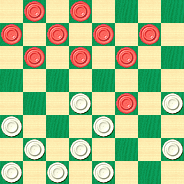
WHITE
White to Play and Win
W:W18,20,21,23,25,26,28,29,30,31:B1,2,5,6,7,8,9,10,11,19.
A---Black gets a rude awakening after this plausible push. The right route to draw is: 11-16, 20-11, 7-16, 18-15, 9-14, 15-11 (25-22, 6-9 draws), 6-9, 25-22, 9-13, 22-18, 10-15, 18-9, 5-14, 29-25, 15-18, 26-22, 18-27, 31-15, 2-6, etc.
The Scrub's Delight
11-15 23-19 8-11 22-17 4-8---A 17-13 15-18 24-20 11-15 28-24 8-11 26-23 9-14 31-26 6-9 13-6 2-9 26-22 9-13---B.
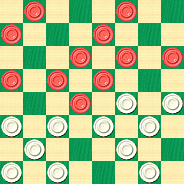
WHITE
White to Play and Win
W:W19,20,21,22,23,24,25,27,29,30,32:B1,3,5,7,10,11,12,13,14,15,18.
The illustrated layout was one of the earliest standard pitfalls to be recorded in checker literature, being first shown, in 1800, by that pioneer chronicler of the checker art, Joshua Sturges. Appropriately labeled "The Scrub's Delight," it has probably dropped more novices than any other trap on the board.
A---Completes the Old Fourteenth opening, one of the first and most popular developments tackled by the learner. Winning chances are about equal.
B---Time-tested standard play to here. The text loses, forming the Scrub's Delight. The correct play to force a draw is: 1-6, 22-17, 18-22, 25-18, 15-22, 23-18, 14-23, 27-18, 9-13, 17-14, 10-17, 21-14, 6-10, 30-25, 10-17, 25-21, 22-26, 21-14, 26-31, 19-15, 31-26, 15-8, 26-22, 32-28, 22-15, 24-19, etc.
Don't get bumped off and don't be a scrub. Try out the problems and then click on Read More to check your solutions.![]()
What's Your Excuse?

"There are various excuses made by checker players as to why they were beaten. It may have been the arrival of a new baby; the unexpected arrival of his mother-in-law; it might have been the toothache the previous night; the baby may have kept him awake all night on account of its having the colic; the weather may have changed suddenly and brought on a twinge of rheumatism; he may not have had the kind of board to play on to which he is accustomed; a spectator may have smiled at a time when smiles were out of order; some one may have opened a window causing a draught; he may have used a line of play given in the book as sound and it turned out otherwise. The foregoing and many others may all be good and valid excuses, but the finest one of all is, the other fellow was a better player."
Printed more than eighty years ago as The Art of Alibi in the Seattle Times, and still relevant today.![]()
The Checker Maven is produced at editorial offices in Honolulu, Hawai`i, as a completely non-commercial public service from which no income is obtained or sought. Original material is Copyright © 2004-2026 Avi Gobbler Publishing. Other material is public domain, AI generated, as attributed, or licensed under CC1, CC2, CC3 or CC4. Information presented on this site is offered as-is, at no cost, and bears no express or implied warranty as to accuracy or usability. You agree that you use such information entirely at your own risk. No liabilities of any kind under any legal theory whatsoever are accepted. The Checker Maven is dedicated to the memory of Mr. Bob Newell, Sr.

